What You Need to Know to Pass Your Special Boilers Exam
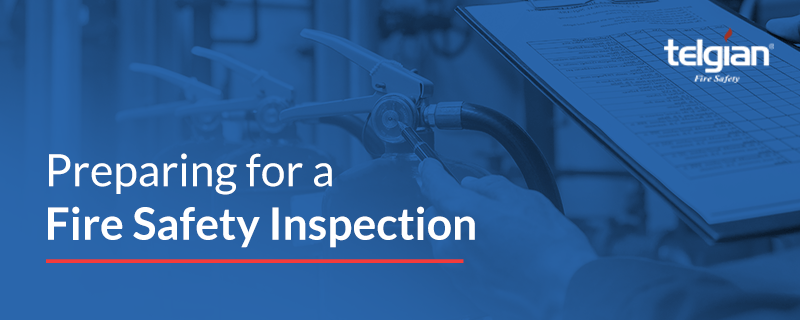
In the United States, a structure fire starts every 63 seconds, and, the consequences tin be devastating for homes and businesses alike. According to the National Burn Protection Association (NFPA), which collects data on fires, including office property fires, firefighters respond to an boilerplate of iii,340 part property fires per year (2007-2011). Office belongings fires were responsible for an average of four civilian deaths and 44 civilian injuries per year. In addition, these fires acquired an average of $112 million annually in direct property impairment.
Keeping safety equipment in good working society is imperative, every bit well. Data shows that sprinkler systems are effective in fighting fires 88% of the time when they are activated. NFPA also reports that death rates in role property fires where sprinkler systems are nowadays are 62% lower than in those without sprinklers.
Keeping a building up to code, withal, can be complicated. For example, the International Burn Lawmaking (IFC) is used in 42 states and the District of Columbia. The NFPA, also has a Fire Prevention Code, NFPA 1, that is utilized past the other states and sometimes in conjunction with the IFC. Both of these documents refer to the family of NFPA codes and standards. States who have not adopted the IFC include Florida, Hawaii, Maine, Maryland, Massachusetts, Rhode Island, Vermont and West Virginia. So, companies located in these states, particularly, volition need to check their local ordinances to find out how to comply with fire safety regulations. It is ever a good idea to know what the local adjustments or amendments are to the national codes.
Staying upwardly to code includes regular fire safety inspections, which help prevent devastating losses from fire. Fire safety inspectors ensure that equipment, such equally sprinkler systems, fume alarms, burn down doors, and burn down alarms perform as they should. Inspectors tin can also check that electrical systems and cooking equipment meet safety standards.
Below, we will walk you lot through the steps to take to make sure your company knows how to pass a potentially life-saving fire prophylactic inspection.
Burn down Safety Inspection Requirements
Fire inspectors accept an important checklist to complete when performing fire condom inspections. Since these requirements vary by land, business organisation owners and managers will need to go familiar with individual state fire codes, ordinances, and standards, every bit well equally how to comply. These fire codes exist to tell businesses what requirements they must meet, what types of equipment they must install based on a construction's size and usage, and how they are to install required equipment.
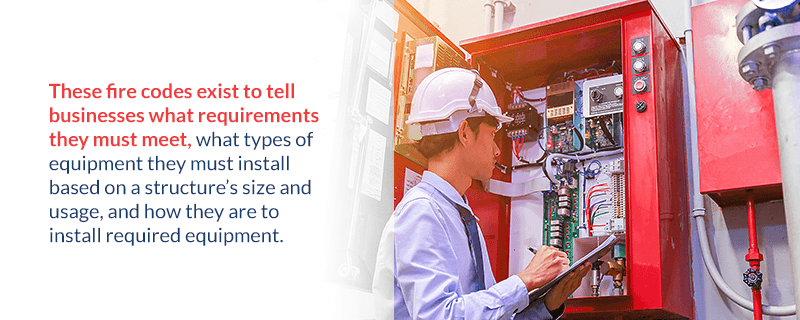
Some types of businesses crave more than frequent fire safety inspections than others. Most companies receive a visit from the burn marshal once a year. Places of public associates, such equally theaters, nightclubs, hotels, and even hospitals, however, need more frequently inspections. And, buildings such as loftier-rises are required to attach to extremely stringent fire code requirements, due to high occupancy and complicated egress for those on college floors. For a building's possessor or manager, burn down inspections may seem like a periodic nuisance. Merely, fire rubber requirements offer valuable benefits to employees, managers and owners akin:
- Workplace safety: Working in a building that passes a burn code inspection gives employees peace of mind almost their security at work.
- Building security: Modern structure codes tin limit full losses from burn down. Keeping a workplace up to code tin can make the difference betwixt saving and losing an entire building.
- Security from concern interruption: When a burn down occurs, business operations are likely to be suspended for days or weeks, if not permanently. Staying upward to code allows businesses to minimize damage and become back to normal operations quickly later on a fire.
- Customer base of operations retention: If a business organisation closes downwardly for weeks due to fire harm, fifty-fifty loyal customers will need to wait elsewhere. Adhering to burn codes provides businesses with a ameliorate take a chance of maintaining clientele.
- More favorable insurance rates: Many insurance companies incentivize the installation of safety features such as smoke detectors and sprinkler systems. Businesses can realize pregnant rate reductions simply by taking this extra stride.
Burn down inspection requirements affect many areas of a building's systems and functionality. Some of these include:
- When doors must remain unlocked
- What types of safety systems must be installed
- How often professional person maintenance must take place
- Where and how materials are stored
- How electrical systems are used and labeled
- Other details of abiding by the burn down code
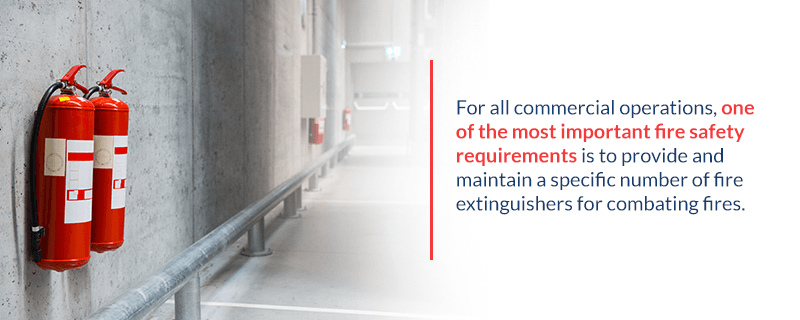
For all commercial operations, 1 of the most of import fire condom requirements is to provide and maintain a specific number of fire extinguishers for combating fires. The number and location of fire extinguishers required in a building depends on the type of extinguishers used. The actual requirements are found in NFPA 10 as well every bit the IFC. Nigh burn extinguishers are classed equally types A, B, C, or Yard. These letter classifications refer to the kind of materials it can extinguish.
- Class A: These burn extinguishers put out trash, woods, and paper fires.
- Grade B: These burn extinguishers are used for flammable liquid fires, such as oil and gasoline fires.
- Class C: These fire extinguishers are safety to use on energized electrical equipment.
- Course G: These burn extinguishers are used for kitchen fires, such as fires that start from called-for grease, fats and oils.
Each fire extinguisher includes an alphanumerical rating, such as i-A. An extinguisher rated 1-A can put out a burn of a particular size. A burn down extinguisher rated 2-A tin can put out a burn about twice equally large.
one. Class A Fire Extinguishers
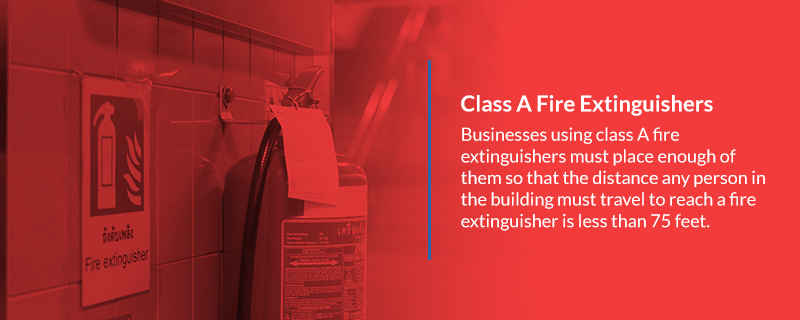
Businesses using class A fire extinguishers must place enough of them so that the altitude any person in the building must travel to reach a fire extinguisher is less than 75 anxiety. Additionally, in areas of low hazard occupancy, each fire extinguisher should cover an surface area of no more than iii,000 square feet per the extinguisher'south A rating. Therefore, an extinguisher rated 2-A (the minimum rating required under the IFC) can encompass 6,000 square anxiety. An extinguisher rated three-A can comprehend nine,000 square feet.
In areas of moderate adventure occupancy, each burn down extinguisher should encompass an area of no more than 1,500 square feet per A rating. Whereas, in areas of loftier hazard occupancy, each fire extinguisher should cover an area of no more than 1,000 square feet per its A rating. No affair its numerical rating, no single type A burn extinguisher should ever embrace more than 11,250 foursquare feet.
ii. Class B and C Burn down Extinguishers
For areas using class B and C fire extinguishers, the altitude that any person in the building must travel to achieve a fire extinguisher is less than thirty or 50 feet, depending on the rating of the fire extinguishers.
In areas of depression hazard, the minimum extinguisher rating is 5-B or v-C. The travel distances to these extinguishers must be less than 30 feet. If fire extinguishers in these areas are rated x-B or 10-C or above, the maximum travel distance must be less than l feet.
In areas of moderate gamble, the minimum extinguisher rating is 10-B or 10-C. The travel distances to these extinguishers must be less than 30 feet. If fire extinguishers in these areas are rated twenty-B or 20-C or above, the maximum travel distance must be less than 50 feet.
In areas of high hazard, the minimum extinguisher rating is 40-B or 40-C. The travel distances to these extinguishers must be less than 30 feet. If burn extinguishers in these areas are rated fourscore-B or 80-C or higher, the maximum travel distance must be less than 50 anxiety.
Almost Facilities utilize extinguishers rated for form A,B & C to see the requirements.
3. Course K Fire Extinguishers
Class K fire extinguishers, used for kitchen fires, must be located within xxx feet of cooking stations. 1 1.v-gallon burn down extinguisher of this type tin embrace a maximum of four moderate-sized fryers. Use of more fryers and cooking stations requires additional extinguishers. If a fixed hood organisation is in identify it should exist utilized first then the portable unit used equally needed.
Preparing for a Fire Safety Inspection: What you need to know
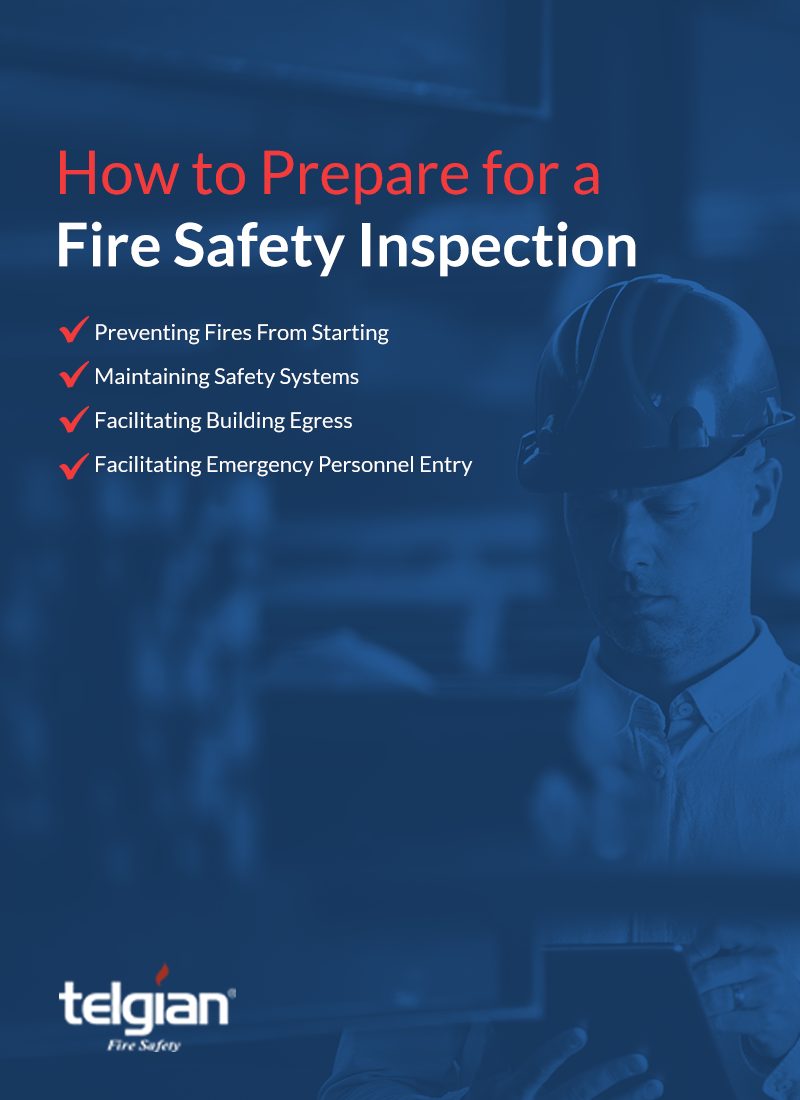
Preparing for a fire prophylactic inspection is critical, specially for businesses subject to unscheduled inspections. With unscheduled inspections, fire inspectors may promise to see what the building's working and safety atmospheric condition are like during a typical day, and not just on the 24-hour interval when managers have specifically prepared for inspection. Being prepared at all times greatly enhances the likelihood of passing a drib-in inspection.
Fire safety inspectors evaluate several areas:
-
- They decide ways that fires could start within the edifice.
- Inspectors bank check the safety systems in identify, such as fume alarms, fire extinguishers, and sprinkler systems. They brand sure these systems are regularly maintained and kept in adept working lodge. They ofttimes request to run across documentation on the maintenance of these systems.
- They check the systems that assist with egress, such as lighted exit signs and get out doors. Inspectors will make certain these features function finer and assist with egress, rather than impeding it.
- Inspectors ensure that emergency personnel have like shooting fish in a barrel, firsthand admission to the building.
Businesses should take these steps to gear up for a fire safety inspection by checking on their compliance within each of these areas.
1. Preventing Fires from Starting
Companies can protect against burn down ignition by making sure electrical systems are in good working order and properly insulated. A building's electrical systems should be inspected at least in one case a year, if not more than often, as required past specific local ordinances.
2. Maintaining Safety Systems
Businesses should always operate and maintain safety systems to assist with detecting, containing, and putting out fires. These systems can include fume alarms to detect signs of fire, fire doors that swing closed automatically when the fire alarm system activates, and sprinkler systems that put out fires past dousing them from above. All of these safety systems should receive regular, professional person inspections and take their batteries and other components replaced as needed.
3. Facilitating Building Egress
The best safety systems in the world are not enough if no i tin can go out of the building. To ensure that employees and guests escape safely from a fire, businesses should install and maintain directional exit lighting and illuminated get out signs. These features allow people to quickly locate the nearest means of egress.
Stairwells and exit hallways should always be free from obstruction, and doors should remain unlocked wherever possible. When doors must stay locked, they must exist like shooting fish in a barrel for a single person to open without the utilize of specialized knowledge, force, or keys.
4. Facilitating Emergency Personnel Entry
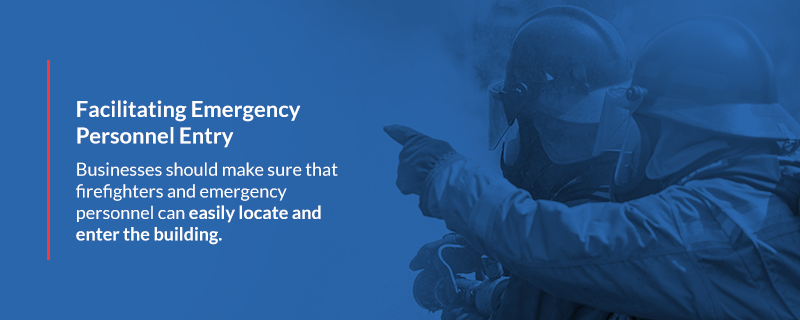
Finally, businesses should make certain that firefighters and emergency personnel can hands locate and enter the building. They can exercise so by displaying the building address prominently (as required by the IFC), clearing fire lanes, and ensuring access to fire hydrants and building keys. If the Fire department has a "lock Box" program make certain that whatever changes fabricated to the keys for the facility are also reflected in this box as well. This could require a call to the fire dept. but most will be glad to stop by if you are beingness proactive in maintaining the access for them. No matter how well you have worked preparing for a fire safety inspection, however, an inspector may find a violation. If that occurs, business owners and managers should be ready to talk to the inspector about the timeline for making corrections. It is also important to understand who is responsible for getting the building into compliance, whether it is the business owner, the property managing director, or the building owner. Sometimes these delegations are included in the charter agreement or other paperwork.
Preparing for a Burn Safety Inspection: Your Burn Inspection Checklist
Your burn safe inspection checklist should include the post-obit important items:
- Collect copies of previous inspection reports.
- Collect proof of arrangement service and inspections.
- Brand appointments for whatsoever outstanding safety systems maintenance.
- Make appointments for any outstanding heat systems maintenance.
- Protect special hazards.
- Articulate hallways and stairwells.
- Shop flammable and flammable materials properly.
- Store incompatible materials separately.
- Ensure quick and easy entry for the burn department.
- Make certain the burn department can access water.
- Label and maintain electrical organization components.
- Use extension cords accordingly.
- Ensure computers accept power strips.
- Text leave signs and directional lighting.
- Assess burn extinguisher location(s).
- Assess sprinkler head clearance.
- Post whatsoever required signage.
By reviewing and completing these items before your burn inspection, you lot'll have a greater chance of passing and remaining in compliance with fire rubber regulations.
one. Collect Copies of Previous Inspection Reports
Being proactive makes a practiced impression and lets the inspector know the visitor is invested in meeting requirements. Provide documentation of steps the visitor took to address any previous violations.
2. Collect Proof of System Service and Inspections
Collect the necessary paperwork to testify that licensed professionals have serviced burn down alarms, fire extinguishers, sprinkler systems and burn down pumps inside the required timeframe. How often is a burn down inspection required? Depending on the blazon of system, fire alarms are typically serviced either annually, semiannually or quarterly.
Collect the necessary paperwork to show that cooking hoods, if applicable, have been serviced past a licensed professional within the required timeframe (usually the past six months for standard cooking operations). Additionally, collect any necessary paperwork to testify that whatsoever generators have been serviced by a licensed professional person inside the required timeframe, usually the past year.
iii. Brand Appointments for any Outstanding Prophylactic Systems Maintenance
Maintain safety systems with the assist of reputable, licensed contractors. Inspection, testing, and maintenance (ITM) of these systems can be circuitous and requires trained professionals with significant expertise in the field.
The company that provides inspection services should be able to complete or coordinate installation and and repair services to make sure everything is working correctly. This visitor should besides provide detailed documentation of any issues and their solutions. Many companies can perform several aspects of ITM at in one case, including checking emergency lighting, leave signs, fire extinguishers, Sprinkler systems, and fire alarms.
4. Make Appointments for any Outstanding Estrus Systems Maintenance
Brand sure all appliances that generate heat are regularly maintained. These appliances include boilers, furnaces, radiators, stoves, ovens, and oestrus-producing manufacturing equipment. In the kitchen, cooking appliances should have hoods and hood suppression systems for automatic suppression of kitchen fires. These systems must also receive regular maintenance.
v. Protect Special Hazards
In a business, special hazards tin can include gasoline pumps, computer server rooms, chemic storage areas, and any other identify with a loftier concentration of flammable or flammable materials. Brand certain these hazards proceeds protection with properly maintained and inspected systems.
6. Clear Hallways and Stairwells
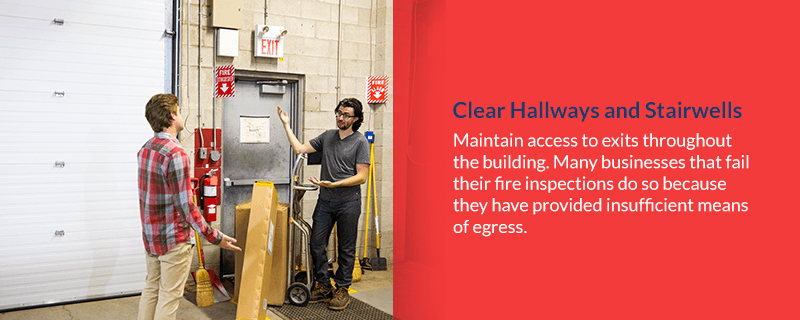
Maintain admission to exits throughout the building. Many businesses that fail their fire inspections exercise and so because they take provided bereft means of egress. For example, businesses may store items in the hallways that lead to go out doors. If a fire occurred, these items would dramatically limit the menstruum of traffic out of the building.
Stairways and corridors should also include features such equally burn down doors and latch release mechanisms. All exit doors should be unobstructed and should open up without difficulty for a single person without specialized keys or cognition.
7. Store Combustible and Combustible Materials Properly
Typically, flammable materials must be stored a certain distance from the ceiling in approved containers that are in skillful condition. Store flammable and flammable materials in amounts that do not exceed the maximums set by each state. Do not shop them in rooms where estrus is produced, such as boiler rooms and electric rooms. Additionally, do not go along them near appliances such every bit coffeemakers, microwaves, stoves or ovens, portable heaters, or any other estrus-producing electronic devices.
viii. Store Incompatible Chemicals Separately
Incompatible materials — for example, ammonia and bleach, which combine to form potentially toxic fumes — must be separated. Typically, they must be at least 20 anxiety away from each other, or separated with a noncombustible sectionalization that extends at least eighteen inches higher up and beyond the incompatible substances.
9. Ensure Quick and Easy Entry for the Fire Department
Have the required steps to help emergency personnel quickly and hands gain access to your building. These steps include labeling the building with clearly marked accost numbers that can be seen from the route and making certain that burn lanes remain unobstructed.
According to national codes, all buildings must requite firefighters rubber and immediate access. Virtually businesses comply with this lawmaking by mounting burn down department lock boxes on their buildings' exteriors. In an emergency, the burn department can open the lock boxes by using a chief key.
10. Make Sure the Burn down Department Tin Admission Water
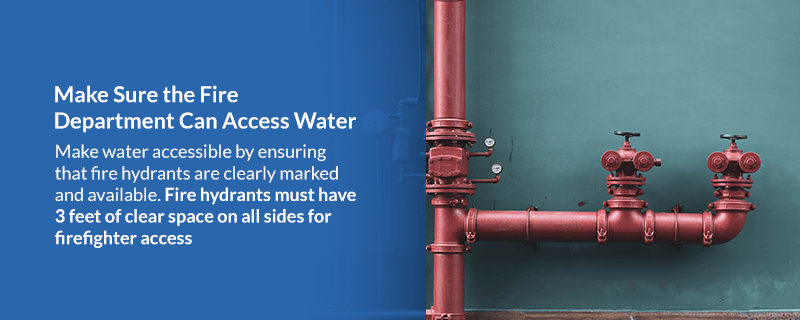
Brand water accessible past ensuring that fire hydrants are conspicuously marked and available. Fire hydrants must take 3 feet of articulate space on all sides for firefighter admission. Prohibiting personal and company vehicles from parking near and blocking fire hydrants is imperative. Additionally, ensure the fire department connexion (FDC) that allows firefighters to supply h2o to a sprinkler system is also conspicuously marked and accessible.
11. Label and Maintain Electrical System Components
All electrical panels should have their circuits properly labeled. In addition, electrical panels should have a clear space of at least 30 inches in front end of them, and so employees can reach them hands and close them off in an emergency. There should be no storage in the electric rooms. All electrical outlets and circuit panels should also accept plate covers for safety.
12. Use Extension Cords Accordingly
Extension cords should exist in skilful condition, intended for heavy-duty utilize, grounded, and used temporarily just with small appliances. Never employ extension cords that are split or frayed. If there are multiple appliances plugged into a surge protector, it must be a power strip with born circuit breakers. Powering a room total of laundry machines with an extension cord, for instance, is a fire code violation. Never staple any electric cord to the wall to keep it out of the way, or hide it under a carpet. Additionally, practise not utilize extension cords as substitutes for permanent wiring.
13. Ensure Computers have Power Strips
Make sure computers are plugged into surge protectors with built-in excursion breakers. Congenital-in circuit breakers assistance reduce the risk of electrical fires. These "ability taps" as the lawmaking calls them must be plugged directly into a wall outlet.
fourteen. Exam Go out Signs and Directional Lighting
Leave signs and emergency lights must work properly, both on regular ability and backup ability. Near exit signs and emergency lighting systems should have bombardment backups. Properly operation lights and signage are crucial and allow employees to escape the building in case of fire.
15. Assess Fire Extinguisher Location(s)
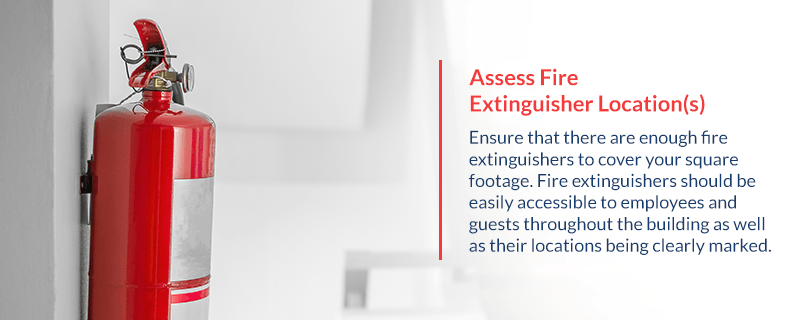
Ensure that there are plenty burn extinguishers to cover your square footage. Fire extinguishers should exist easily attainable to employees and guests throughout the building as well as their locations being clearly marked .
16. Assess Sprinkler Head Clearance
Make sure ceiling sprinkler heads have 18 inches of clearance. Maintaining space around overhead sprinklers helps them distribute h2o effectively in a burn down. Buildings that are not protected by sprinklers require a minimum of 24″ of clearance from ceiling to tiptop of storage.
17. Post any Required Signage
Throughout the edifice, mail signage indicating the all-time escape pathways to exits. These signs should be posted in every main surface area of the edifice.
Proceed the front end door unlocked and post a sign nearby instructing people to keep the door unlocked when the expanse is occupied. Keeping the forepart door unlocked is required by law and keeps people from getting trapped in the building during a burn.
In every room designated for assembly, post a permanent sign declaring the maximum occupancy of that room. This sign should be clear and legible and posted conspicuously virtually the master exit doorway.
Near the elevators, post a sign equally a reminder to use the stairs, not the elevator, in example of an emergency. Elevators can malfunction during a burn down and trap people inside.
Preparing for a Burn Safety Inspection: Inspections Save Lives
Finally, recollect that, no matter how inconvenient fire inspections may seem, they take place to ensure the safe of anybody who works in the visitor. A fire inspection tin exist difficult, but the harm or loss of life acquired in a fire can devastate a business, often permanently.
Prepare for a Fire Safety Inspection with Telgian Fire Safety
Telgian Burn down Safety offers a variety of resources to assist prepare for a fire safety inspection. Telgian's testing, inspection, maintenance, and repair expertise includes fire sprinklers, burn down alarms, burn extinguishers, kitchen hood suppression systems, backflow systems, emergency and get out lights, special hazards, and clean amanuensis systems, too as fire alarm monitoring.
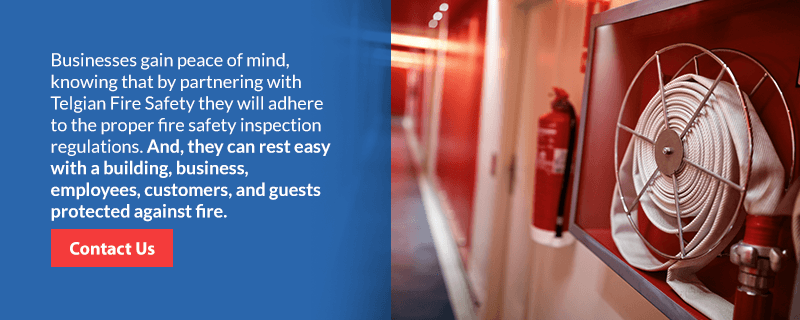
Businesses proceeds peace of mind, knowing that by partnering with Telgian Burn Safe they will adhere to the proper fire rubber inspection regulations. And, they can residuum easy with a edifice, concern, employees, customers, and guests protected against fire.
Call or electronic mail us today to get started in preparing for a fire inspection.
Last updated April sixteen, 2021.
cashwelllouns1959.blogspot.com
Source: https://www.telgian.com/preparing-fire-inspection/
0 Response to "What You Need to Know to Pass Your Special Boilers Exam"
Postar um comentário